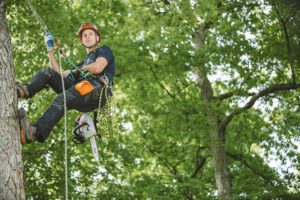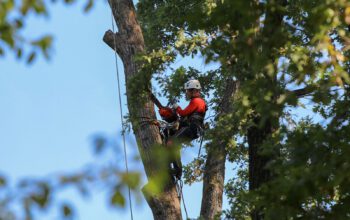Tree care involves a variety of services that ensure trees are healthy and looking their best. This includes selecting the right tree for a specific area, planting it properly, and watering it appropriately.

Discolored leaves or early leaf drops are signs that a homeowner should contact an arborist. An ounce of prevention is worth a pound of cure.
Trees add beauty to the landscape and increase property values, but removing them may be necessary when they’re diseased or in poor condition. The process is typically more complex and time-consuming, requiring special equipment and techniques to prevent damage to surrounding trees and property. And in the event that a dying or dead tree is located near power lines or other structures, it’s often best to have the tree removed by professional arborists rather than trying to do it yourself.
Removing a tree can also be very expensive, depending on the size of the tree and its location. Larger trees are usually more difficult to remove and require the use of specialized machinery, increasing the price. And if the tree is located close to power lines, it’s typically not a do-it-yourself project, as there are serious safety risks involved.
The cost of removing a tree also depends on the size and location of the stump, as well as how much debris needs to be hauled away. For example, a small tree’s stump will be more inexpensive to remove than a larger one because it’s less work for the company doing the job. Finally, if the tree is located in a city or town right-of-way, it may be more expensive because it will require a permit or written permission from the local government.
Another service provided by professional tree services is cabling and bracing, which involves installing support systems to protect a weak or damaged tree from falling over during storms or high winds. This is a common request from homeowners, as they want to ensure their properties and people are safe in the event of a disaster.
When searching for a professional to handle your tree removal, look for a company with experience and the proper equipment. It’s also a good idea to ask for referrals from friends and family, as they can point you in the direction of a great tree care company. And be sure to inquire about the company’s insurance coverage, as they should have a good amount of liability coverage in case anything goes wrong while they’re on the job.
Tree Pruning
A common part of tree care, pruning is the removal of specific branches and limbs to keep trees in a desired shape or size. It also helps control growth and removes diseased, damaged or dead branches, as well as promoting new growth.
Pruning is best performed while the plant is dormant, usually in late winter or early spring. This allows the tree to recover from cuts before the summer heat sets in and reduces the risk of injury to people, cars or structures from falling limbs.
When done properly, pruning can improve the overall health and appearance of your landscape while removing dangerous and unsightly limbs. Tree pruning also prevents damage to property and people caused by limbs that fall during storms or high winds.
The type of pruning required varies depending on the tree’s condition and goals. For example, reducing density is most often conducted on younger trees to increase wind or sunlight penetration and promote interior foliage development. This method also eliminates inward-growing limbs, branches that obstruct traffic or buildings and narrow V-shaped crotches.
Crown reduction, on the other hand, is more commonly used on older and mature trees to reduce their height or width. This is often necessary to reduce the risk of failure of large limbs, maintain safety clearances or allow for future utility access.
Some shrubs and hedges also benefit from pruning to remove twiggy growth, slow growth, and encourage re-blooming. These plants include azalea, rhododendron, mountain laurel, forsythia, lilac and chokeberry.
Tree Maintenance
Tree care is a complex process and involves many tasks including regular inspections, fertilizing, pruning and removal. Keeping trees healthy and well-maintained is crucial to a property’s overall beauty, value, and function. Trees provide shade, increase property value, and save energy by insulating soil from summer heat and protecting it from winter wind. They also improve the appearance of a property, block noise and traffic, and improve air quality.
Pruning is a major part of tree maintenance and involves trimming the branches and limbs of a tree to remove dead, diseased or unsightly twigs and foliage and thin the canopy for light, ventilation, and clearance purposes. A trained professional will use shears and other tools to trim green growth, promoting healthier and more aesthetically pleasing foliage. They will also prune to keep limbs from growing into power lines or structures, encroaching on sidewalks and driveways, and preventing them from damaging property foundations and walls.
Another aspect of tree care is fertilizing, which is a key element to plant health and helps with water uptake. It’s important to fertilize the correct amount, however, and not over-fertilize as this can cause tree stress. Often, a qualified arborist will do a soil test to determine which nutrients are missing in the soil and recommend the appropriate fertilizer.
In addition to pruning and fertilizing, a tree service will also perform other types of maintenance, such as cabling and bracing for trees at risk of falling over or to prevent damage during storms. They can also assist with stump grinding, which involves using a machine to grind down a stump and allow for new grass or other plantings to take its place.
Unlike landscaping companies, who focus on lawn and shrubs, tree services are trained in all aspects of caring for the health and look of a property’s trees. They are able to handle large, heavy equipment and follow standardized safety practices. Those who choose to use a tree service company should ensure that the professionals they hire are fully licensed and insured. They should also be ISA certified and have extensive experience in the field.
Tree Inspection
Just like an annual doctor’s appointment, regular tree inspections can save you money in the long run by identifying any issues and treating them as soon as possible. If left untreated, diseases or pests can spread quickly and damage your trees and property.
Regular inspections help identify structural weaknesses and potential safety hazards, enabling timely interventions such as pruning, fertilization, or pest control. This ensures that the health, vigor and useful life expectancy of your trees are preserved. In addition, it prevents the need for costly removal or replacement of a tree that has been damaged or has become diseased.
A trained arborist can spot problems from the ground, but as he or she moves their line of sight up the trunk and into the canopy, they are also inspecting the structure of the limbs and how they attach to the tree. As a result, it is not uncommon for a professional to notice a broken limb or a crack in the bark that you would never have seen.
During the inspection, the arborist will look for signs of pests, such as fungi or insects, as well as diseases. Insects can disrupt the flow of nutrients in the tree, causing stress and weakening the overall structure. Insects may also introduce harmful pathogens or fungi that can further compromise a tree’s health.
When an insect or disease is identified, the arborist will suggest a treatment plan for that particular problem. This may involve the use of chemical or non-chemical methods, such as fertilization or mulching. In some cases, the problem may be so serious that the only option will be to remove the tree.
As part of the inspection process, the arborist will also advise on a watering regime. This will be based on the specific type of tree, its age, weather conditions and the soil it grows in. Good, nutrient-rich soil is essential for healthy and mature trees.

